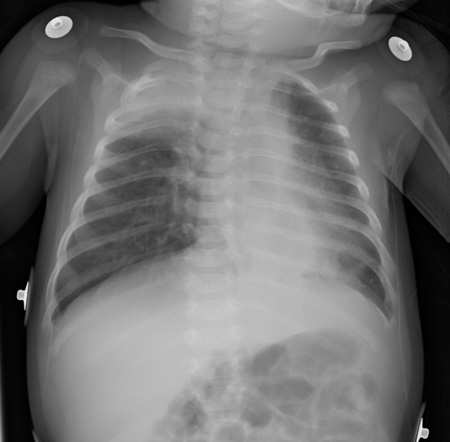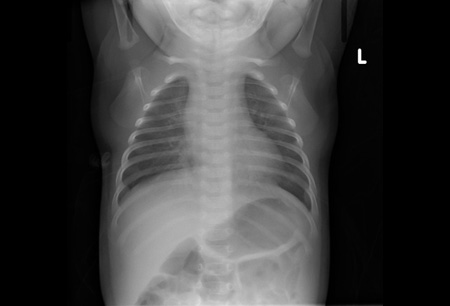Tests
1st tests to order
pulse oximetry
Test
A rapid and accurate method for evaluating hypoxemia, its use should be considered in any infant with moderate to severe symptoms.[2] Routine pulse oximetry use has not been shown to improve outcomes. Do not use continuous pulse oximetry in children unless they are receiving supplemental oxygen.[100]
Result
hypoxemia
Investigations to avoid
broad respiratory pathogen panels
Recommendations
Do not order broad respiratory pathogen panels, including comprehensive viral panel testing, unless the result will directly influence management decisions.[98][99]
Rationale
Bronchiolitis is a clinical diagnosis and usually does not require confirmatory viral testing unless an infant receiving monthly prophylaxis is hospitalized with bronchiolitis.[2] There is also a lack of consistent evidence to demonstrate the impact of comprehensive viral panel results on clinical outcomes.[114]
Tests to consider
chest x-ray
Test
Reveals atelectasis, hyperinflation, peribronchial cuffing, and infiltrate.[Figure caption and citation for the preceding image starts]: AtelectasisFrom the personal collections of Melvin L. Wright, DO and Giovanni Piedimonte, MD; used with permission [Citation ends]. [Figure caption and citation for the preceding image starts]: Air trapping and peribronchial cuffingFrom the personal collections of Melvin L. Wright, DO and Giovanni Piedimonte, MD; used with permission [Citation ends].
[Figure caption and citation for the preceding image starts]: Air trapping and peribronchial cuffingFrom the personal collections of Melvin L. Wright, DO and Giovanni Piedimonte, MD; used with permission [Citation ends].
Should be reserved for those patients with severe disease, and those who do not improve at the expected rate.[2][112]
Result
atelectasis, hyperinflation, peribronchial cuffing, infiltrate
hydration status
Test
Clinically assess the hydration status of babies and children with bronchiolitis to determine the hydration requirements of the patient.[51]
Result
Hypovolemic, euvolemic or hypervolemic
rapid antigen detection from respiratory specimen (e.g., nasopharyngeal aspirate)
Test
Commercially available and relatively easy to use. Sensitivity >90% in young children, but is lower in older children and adults.[113]
Result
detection of viral antigen
reverse transcriptase polymerase chain reaction of respiratory specimen (e.g., nasopharyngeal aspirate)
Test
A rapid and sensitive method for detecting respiratory syncytial virus.
The preferred method of viral testing at most large medical centers.
Clinical sensitivity superior to other diagnostic modalities.
Result
detection of viral RNA
Use of this content is subject to our disclaimer